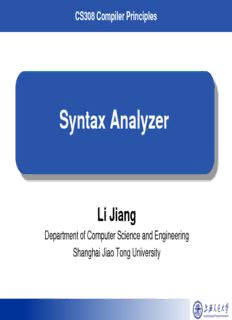
Parser / Syntax Analyzer PDF
Preview Parser / Syntax Analyzer
CS308 Compiler Principles Syntax Analyzer Li Jiang Department of Computer Science and Engineering Shanghai Jiao Tong University Syntax Analyzer • Syntax Analyzer creates the syntactic structure of the given source program. • This syntactic structure is mostly a parse tree. • Syntax Analyzer is also known as parser. • The syntax of a program is described by a context-free grammar (CFG). We will use BNF (Backus-Naur Form) notation in the description of CFGs. • The syntax analyzer (parser) checks whether a given source program satisfies the rules implied by a context-free grammar or not. – If it satisfies, the parser creates the parse tree of that program. – Otherwise the parser gives the error messages. • A context-free grammar – gives a precise syntactic specification of a programming language. – the design of the grammar is an initial phase of the design of a compiler. – a grammar can be directly converted into a parser by some tools. 2 Compiler Principles Parser / Syntax Analyzer • Parser works on a stream of tokens. • The smallest item is a token. token Lexical Parser source parse tree program Analyzer get next token • The parser obtains a string of tokens from the lexical analyzer, and verifies that the string of token names can be generated by the grammar for the source language. 3 Compiler Principles Parsers Cont’d We categorize the parsers into two groups: 1. Top-Down Parser – the parse tree is created top to bottom, starting from the root. 2. Bottom-Up Parser – the parse is created bottom to top; starting from the leaves • Both scan the input from left to right (one symbol at a time). • Efficient top-down and bottom-up parsers can be implemented only for sub-classes of context-free grammars. – LL for top-down parsing – LR for bottom-up parsing 4 Compiler Principles Outline • Context Free Grammar • Parse Tree • Top-down Parser • Bottom-up Parser 5 Compiler Principles Context-Free Grammars • Recursive structures of a programming language are defined by a context-free grammar. • A context-free grammar consists of: – A finite set of terminals (in our case, these will be the set of tokens) – A finite set of non-terminals (syntactic-variables) – A finite set of production rules in the following form • A where A is a non-terminal and is a string of terminals and non-terminals (including the empty string) – A start symbol (one of the non-terminal symbol) • Example: E E + E | E – E | E * E | E / E | - E E ( E ) E id 6 Compiler Principles Derivations E E+E • E derives E+E (E+E derives from E) – we can replace E by E+E – we have to have a production rule EE+E in our grammar. E E+E id+E id+id • A sequence of replacements of non-terminal symbols is called a derivation of id+id from E. • In general a derivation step is A if there is a production rule A in our grammar where and are arbitrary strings of terminal and non-terminal symbols ... ( derives from or derives ) 1 2 n n 1 1 n : derives in one step ** : derives in zero or more steps ++ : derives in one or more steps 7 Compiler Principles CFG - Terminology • L(G) is the language of grammar G (the language generated by G). It is a set of sentences. • A sentence of L(G) is a string of terminal symbols of G. • If S is the start symbol of G then ** is a sentence of L(G) iff S , where is a string of terminals of G. • If G is a context-free grammar, L(G) is a context-free language. • Two grammars are equivalent if they produce the same language. ** • S - If contains non-terminals, it is called as a sentential form of G. - If does not contain non-terminals, it is called as a sentence of G. 8 Compiler Principles Derivation Example E -E -(E) -(E+E) -(id+E) -(id+id) OR E -E -(E) -(E+E) -(E+id) -(id+id) • At each derivation step, we can choose any of the non-terminal in the sentential form of G for the replacement. • If we always choose the left-most non-terminal in each derivation step, this derivation is called as left-most derivation. • If we always choose the right-most non-terminal in each derivation step, this derivation is called as right-most derivation. 9 Compiler Principles Left-Most and Right-Most Derivations Left-Most Derivation E -E -(E) -(E+E) -(id+E) -(id+id) lm lm lm lm lm Right-Most Derivation E -E -(E) -(E+E) -(E+id) -(id+id) rm rm rm rm rm • The top-down parsers try to find the left-most derivation of the given source program. • The bottom-up parsers try to find the right-most derivation of the given source program in the reverse order. 10 Compiler Principles
Description: